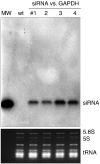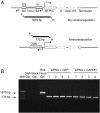L1 retrotransposon-mediated stable gene silencing
- PMID: 15800208
- PMCID: PMC1072808
- DOI: 10.1093/nar/gni056
L1 retrotransposon-mediated stable gene silencing
Abstract
RNA interference (RNAi) is widely used for functional studies and has been proposed as a potential therapeutic agent. Current RNAi systems are largely efficient, but have limitations including transient effect, the need for viral handling and potential insertional mutations. Here, we describe a simple L1 retrotransposon-based system for the delivery of small interfering RNA (siRNA) and stable silencing in human cells. This system demonstrated long-term siRNA expression and significant reduction in both exogenous and endogenous gene expression by up to 90%. Further characterization indicated that retrotransposition occurred in a controlled manner such that essentially only one RNAi-cassette was integrated into the host genome and was sufficient for strong interference. Our system provides a novel strategy for stable gene silencing that is easy and efficient, and it may have potential applications for ex vivo and in vivo molecular therapy.
Figures






Similar articles
-
A potential role for RNA interference in controlling the activity of the human LINE-1 retrotransposon.Nucleic Acids Res. 2005 Feb 8;33(3):846-56. doi: 10.1093/nar/gki223. Print 2005. Nucleic Acids Res. 2005. PMID: 15701756 Free PMC article.
-
Transposon-based RNAi delivery system for generating knockdown cell lines.Biochem Biophys Res Commun. 2004 Apr 9;316(3):643-50. doi: 10.1016/j.bbrc.2004.02.090. Biochem Biophys Res Commun. 2004. PMID: 15033448
-
Stable integration of transgenes delivered by a retrotransposon-adenovirus hybrid vector.Hum Gene Ther. 2001 Jul 20;12(11):1417-28. doi: 10.1089/104303401750298571. Hum Gene Ther. 2001. PMID: 11485633
-
Modulation of gene expression by siRNA in hematopoietic cells.Curr Opin Drug Discov Devel. 2005 Mar;8(2):262-9. Curr Opin Drug Discov Devel. 2005. PMID: 15782549 Review.
-
RNAi in functional genomics.Curr Opin Mol Ther. 2004 Apr;6(2):129-35. Curr Opin Mol Ther. 2004. PMID: 15195923 Review.
Cited by
-
Nef Suppresses LINE-1 Retrotransposition through Two Distinct Mechanisms.J Virol. 2022 Oct 26;96(20):e0114822. doi: 10.1128/jvi.01148-22. Epub 2022 Oct 5. J Virol. 2022. PMID: 36197106 Free PMC article.
-
A LINE-1 component to human aging: do LINE elements exact a longevity cost for evolutionary advantage?Mech Ageing Dev. 2010 May;131(5):299-305. doi: 10.1016/j.mad.2010.03.008. Epub 2010 Mar 25. Mech Ageing Dev. 2010. PMID: 20346965 Free PMC article. Review.
-
The L1 retrotransposition assay: a retrospective and toolkit.Methods. 2009 Nov;49(3):219-26. doi: 10.1016/j.ymeth.2009.04.012. Epub 2009 May 4. Methods. 2009. PMID: 19398011 Free PMC article. Review.
-
The potential regulation of L1 mobility by RNA interference.J Biomed Biotechnol. 2006;2006(1):32713. doi: 10.1155/JBB/2006/32713. J Biomed Biotechnol. 2006. PMID: 16877813 Free PMC article.
-
Genes Encoding Multiple Modulators of the Immune Response Are Methylated in the Prostate Tumor Microenvironment of African Americans.Cancers (Basel). 2025 Jul 19;17(14):2399. doi: 10.3390/cancers17142399. Cancers (Basel). 2025. PMID: 40723280 Free PMC article.
References
-
- McManus M.T., Sharp P.A. Gene silencing in mammals by small interfering RNAs. Nature Rev. Genet. 2002;3:737–747. - PubMed
-
- Dorsett Y., Tuschl T. siRNAs: applications in functional genomics and potential as therapeutics. Nature Rev. Drug Discov. 2004;3:318–329. - PubMed
-
- Song E., Lee S.K., Wang J., Ince N., Ouyang N., Min J., Chen J., Shankar P., Lieberman J. RNA interference targeting Fas protects mice from fulminant hepatitis. Nature Med. 2003;9:347–351. - PubMed

